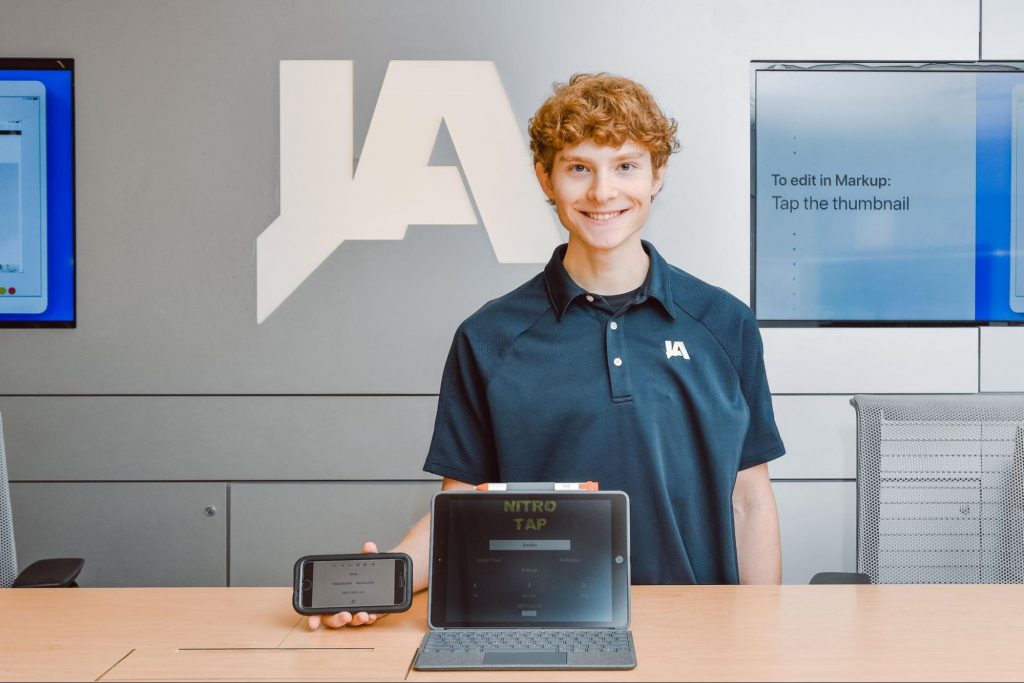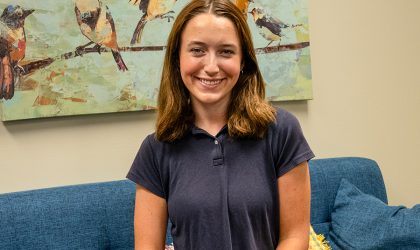

Sandon Guild remembers being fascinated by how software programs worked as a first grader. This year, the Jackson Academy senior has created three apps that have been approved by Apple for purchase through the App Store.
“Since the first video game I ever played, I have been fascinated by how software programs can perform complex processes with simply a few taps of the screen or button pressed on a controller,” Sandon said. “As I occasionally played video games, I was continually thinking of ways to improve them and knew as early as the first grade that I wanted to create my own one day. I always had a couple of app ideas at any given time and knew the real challenge would be legitimately learning to code.”
Teaching oneself to code requires drive, patience—and ample time. For a busy high school student, time is a significant barrier. Then, sheltering at home during the pandemic opened up Sandon’s schedule. Before long, Sandon was coding his way to three apps that had the potential for actual consumer use.
“The summer before tenth grade, I decided to take the leap from websites that taught various coding skills to fully learning an actual programming language,” he explained. “I chose Apple’s native language, Swift, and audited a 60-hour online course hosted in London, England, from January to March in 2020. By the end of the summer, I had nearly playable versions of two apps, and it was at that moment that I knew this dream was one step closer to becoming a reality.”
“I love to code, but it takes an incredible amount of time to make most any feasible progress and is quite challenging far more often than not,” he said. “However, once you learn the basics, it is quite an enjoyable process accompanied by a huge sense of accomplishment every time the code behaves in the way that you intended.”
School-age students from middle school up are the target audience for the first two apps, but those beyond high school can benefit from them. The third app is designed for teachers.
“My first app, Make It Eight, is a number problem-solving game that uses addition, subtraction, multiplication, and division to expand your critical thinking skills by combining a series of numbers in such a way that the result is 8,” Sandon said. “The game contains just over 100 levels that vary somewhat in difficulty, with the easier ones geared towards those still in middle school and harder ones for high schoolers and beyond.”
The second app is ideal for students who are learning keyboarding skills, who want to increase their accuracy, or who really dislike sending “crazily autocorrected text messages,” Sandon said. Nitro Tap is a texting game designed to improve accuracy and punctuation while reducing reliance on autocorrect. It strengthens typing skills if played with a keyboard on an iPad. In Nitro Tap, players race against artificial intelligence to see who can accurately enter sentences the fastest. Nearby friends within Bluetooth range can challenge one another.
Sandon developed his third app to assist teachers, particularly his Upper School math teacher, Wanda Pearcy. “One day in class, Mrs. Pearcy described to me an app that she envisioned to assist with picking students to answer questions,” Sandon said. “This app would randomly select a student from a list to be called on in class and possibly play some background music as well. This idea later took the form of Classroom Roulette and can now benefit any teacher with an iOS device.”
Pearcy is delighted that one of her students would create an app for classroom use. “Sandon made me a neat little timer/random-name-caller app. I think it’s interesting that we have students who will make apps for their teachers,” she said. Teachers can enter up to 30 names per class and save class periods in settings. The app also has the benefit of eliminating unintentional bias when calling on students in a classroom setting.
“Make It Eight and Nitro Tap took an entire summer, working on them most days for around eight hours, but were well worth the effort,” he said. “By the time I tried Classroom Roulette, I had retained enough basic knowledge to move through it much more swiftly than my first two but still continue to learn new concepts and ways to maximize coding daily.”
Although Sandon intended to submit applications to the App Store early in his junior year, the App Store requires applicants to be 18. Once he turned 18 in April, he discovered other hurdles, all of which he overcame.
Sandon first had to copyright the app’s software to publish the app to the App Store. It required filling out a legal application, attaching 50 pages of code, and submitting the application to the U.S. Copyright Office with the help of LegalZoom.
“Copyright attainment, like much of this experience, proved to be quite complicated the first time through, with a number of setbacks, but not nearly as bad the second time,” he said. The application process took two to three months. Apple also required a website for app support purposes which led to Sandon’s company, Sandstorm Command, and sandstormcommand.com.
Learning to persevere through these requirements has given Sandon confidence and is helping him anticipate other goals. “Now that I have gotten to this point in a process that was nearly too daunting to undertake, I feel ready to undertake the next steps of creating an online server and finding a way to make some revenue off of these apps,” he said.
While Sandon has followed an interest he clearly felt early in life, he is quick to credit his teachers for inspiring him. “JA’s teachers and environment have supported me by creating an atmosphere of perseverance and by demonstrating how to improve rather than become discouraged in the face of adversity,” he said. “JA has also provided me with coding inspiration through Mrs. Pearcy.”
The inspiration was quite effective. “After completing these three apps for a combined 15,249 lines of code, I now feel sufficiently warmed up and have begun the strategy game I’ve wanted to make since the beginning, which contains aspects of chess, LEGO™ Battles, and Minecraft™,” Sandon said. “Coding may be a bit of a time investment, but once you start, the time flies by as you pour out ideas in the form of keywords and small pieces of text that magically take on meaning when you interact with your app.”
Jackson Academy has continued to support Sandon by making his apps available to faculty and students, said JA’s Apple Systems Administrator Lori Snider. “We have purchased copies of all three apps and distributed them to our teachers and students to install on their iPads through Self Service. This is our first student-created iOS app, and we are thrilled to share it with our teachers and students, Snider said.


